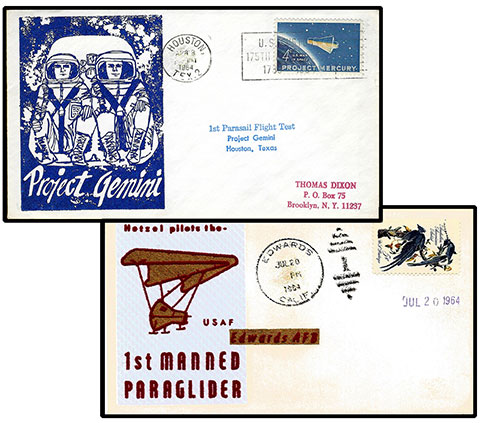Above: At top, the only cover known by this author for the first test of an alternative manned recovery system to the parachutes of Project Mercury. The test actually occurred in Galveston, which is a few miles closer to the Gulf Coast than the Manned Spacecraft Center.At bottom, a July 20, 1964 cover for a Gemini paraglider test flight. This was another alternate system to parachutes. Like the Parasail shown above, it did not work well and parachutes continued to be used throughout the Gemini and Apollo manned spaceflight programs.
Space Cover #485: Project Gemini Parasail and Paraglider Experiments
In writing my U.S. Space Cover Collecting Handbook in 2011, I was able to find information about a Gemini parasail test on April 8, 1964, the same day as the Gemini-Titan I test flight at Cape Canaveral, along with five tests in April, May and July of 1964. At that time, I wrote that there were no known covers.
However, since then I have found one cover ostensibly from Houston for the April 8 test and one for a Manned Paraglider Test at Edwards Air Force Base on a Goldey cachet dated July 20, 1964. I just located information on the latter test. It was a Test Tow Vehicle (TTV) flight by Charles Heizel, a pilot who had already been trained on the Parasev contraption built by Milt Thompson with help from Neil Armstrong.
The two men created an inexpensive training vehicle for learning enough to make the Paraglider tests work out positively. They had worked behind the back of the Flight Research Center's director, Paul Bickle, who had denied Thompson's request to investigate the flight characters of the paraglider.
Parasev 1 looked like a big tricycle made of steel tubing sitting under a fabric Rogallo wing. Francis Rogallo developed the two-lobe, single curvature suspension load wing that combined the slowing properties of a parachute with the rigid flexibility of an aircraft wing.
Despite several tests, the two programs were abandoned with splashdown landings continuing through the end of the Apollo program.












